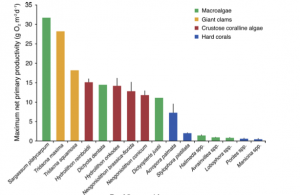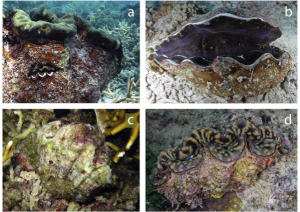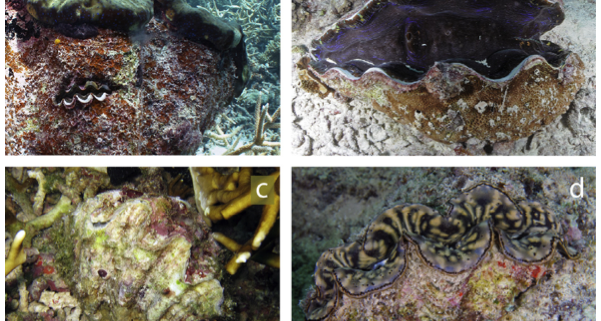The Understanding of Giant Clams’ Contributions to Coral Reef Health Continues to Grow
by James Keegan, RJD intern
Coral reefs suffer from a multitude of problems, such as global warming and ocean acidification, which can be deadly for the reefs. Other issues, like losing individual species, although troublesome, do not garner the same attention because they do not cause as much harm. However, each reef organism has their role to play in the ecosystem, and because of their wide range of functions and highly threatened status, giant clams may deserve special consideration. Currently, the 13 known species of giant clams live in the Indo-West Pacific. The largest species, Tridacna gigas, can reach shell lengths of 120 cm (~3 ft 11 in) and weights in excess of 200 kg (~441 lbs). Because of their high tissue mass and heavy calcified shells, humans have been using them for both food and building material. Along with this demand, habitat degradation, technological advances in exploitation, and expanding trade networks have decreased giant clam numbers throughout their range. Moreover, giant clams are especially vulnerable to this sort of depletion because of their late sexual maturity, sedentary lifestyle, and external fertilization through broadcast release of reproductive cells. Fertilization success requires a sufficient number of spawning individuals, and low densities result in reduced, or zero, juvenile survival and eventual population collapse.
Although giant clams are protected under international law, their stocks are declining rapidly in many countries, and local extinctions are occurring. Such losses could have an unknown number of consequences because giant clams’ significance in coral reefs is not well understood. Giant clams serve several ecological functions in coral reef ecosystems, but conservationists have not previously assessed the extent to which these functions impact the local ecosystem. To rectify this, Neo et al. 2015 used data from literature and their own studies to determine a more accurate assessment of the role giant clams play in coral reefs.
Neo et al. 2015 sought out to properly establish and quantify giant clams’ contribution to reef ecosystems. They used the data obtained from the literature to consolidate information as well as calculate parameters like population density, size distribution, biomass, shell weight, and production. They found that giant clams provide food for local organisms directly through their tissue and indirectly through the discharge of feces, gametes (reproductive cells), and zooxanthellae (photosynthetic algae). Other organisms can also take up and host the zooxanthellae that giant clams expel.

Figure 1: Maximum net primary productivity (NPP) of different reef flora and fauna, measured in terms of net oxygen production (units are in terms of grams of oxygen produced per meter squared per day). The two giant clam species listed have the second and third greatest NPP, beating out hard corals and most algae. (Neo et al. 2015)
Furthermore, the shells of giant clams provide a surface for colonization by epibionts, organisms that live on the surface of other living organisms. An example of an epibiont would be a barnacle. Giant clams serve as nurseries and refugees for fish on the reef as well, and they can even shelter anemone fish in the absence of host anemones. The space between the outer wall of the clam’s soft body and its internal organs, known as the mantle cavity, also provides a habitat for symbiotic organisms.

Figure 2: Epibiota diversity among giant clam species. The ones shown on the giant clams in each picture are: (a) another clam (b) hard coral (c) algae and (d) a variety of encrusting organisms. (Neo et al. 2015)
Moreover, giant clams counteract eutrophication, the nutrient enrichment of water that typically leads to excessive algal growth, by filtering the water and sequestering nutrients. Giant clams also contribute to the topographic relief of reefs, which in itself modifies or creates habitat and affects local water flow. This alteration in water flow benefits the reef by hindering sedimentation and improving food influx. Finally, giant clams make their shells out of calcium carbonate, the same material hard corals use for their skeletons, so their shell material can be incorporated into the reef framework.
Giant clams benefit coral reefs in many ways, and their presence is indicative of reef health. Unfortunately, overfishing has put giant clams under great pressure, and their local extinction could be detrimental to coral reefs. By enhancing the understanding of giant clam contributions to coral reefs, Neo et al. 2015 hope to reinforce the case for their conservation.
References
Neo, M.L., Eckman, W., Vicentuan, K., Teo, S.L.-M., Todd, P.A. (2015) The Ecological Significance of Giant Clams in Coral Reef Ecosystems. Biological Conservation, 181: 111-123. doi:10.1016/j.biocon.2014.11.004




Leave a Reply
Want to join the discussion?Feel free to contribute!